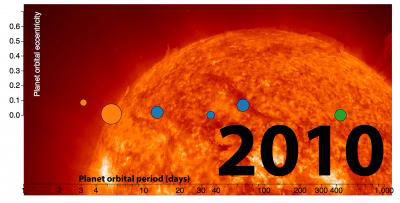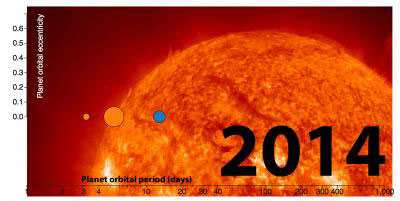| Jul 03, 2014 |
Controversial clues of 2 'Goldilocks planets' that might support life are proven false
|
|
(Nanowerk News) Mysteries about controversial signals coming from a dwarf star considered to be a prime target in the search for extraterrestrial life now have been solved in research led by scientists at Penn State University. The scientists have proven, for the first time, that some of the signals, which were suspected to be coming from two planets orbiting the star at a distance where liquid water could potentially exist, actually are coming from events inside the star itself, not from so-called "Goldilocks planets" where conditions are just right for supporting life.
|
|
The study will be published by the journal Science in its online Science Express issue on July 3, 2014 ("Stellar activity masquerading as planets in the habitable zone of the M dwarf Gliese 581") and in a future print edition of the journal.
|
|
"This result is exciting because it explains, for the first time, all the previous and somewhat conflicting observations of the intriguing dwarf star Gliese 581, a faint star with less mass than our Sun that is just 20 light years from Earth," said lead author Paul Robertson, a postdoctoral fellow at Penn State who is affiliated with Penn State's Center for Exoplanets and Habitable Worlds. As a result of this research, the planets now confirmed to be orbiting this dwarf star total exactly three.
|
 |
| This image shows the location of the six candidate planets that were believed to orbit the red dwarf star Gliese as of 2010. Blue indicates candidate planets in the habitable zone where conditions might be able to support life, orange indicates detections in the too-hot region that is too close to the star, green indicates detections in the too-cold region farther away from the star. (Image: NASA/Penn State University)
|
|
"We also have proven that some of the other controversial signals are not coming from two additional proposed Goldilocks planets in the star's habitable zone, but instead are coming from activity within the star itself," said Suvrath Mahadevan, an assistant professor of astronomy and astrophysics at Penn State and a coauthor of the research paper. None of the three remaining planets, whose existence the research confirms, are solidly inside this star system's habitable zone, where liquid water could exist on a rocky planet like Earth.
|
|
Astronomers search for exoplanets by measuring shifts in the pattern of a star's spectrum -- the different wavelengths of radiation that it emits as light. These "Doppler shifts" can result from subtle changes in the star's velocity caused by the gravitational tugs of orbiting planets. But Doppler shifts of a star's "absorption lines" also can result from magnetic events like sunspots originating within the star itself -- giving false clues of a planet that does not actually exist. "In the search for low-mass planets," Mahadevan said, "accounting for the subtle signature of a magnetics events in the star is as important as obtaining the highest possible Doppler precision."
|
 |
| This image shows the location of the three planets remaining in 2014 after a series of studies since 2004. Research published in 2014, led by Penn State astronomers, shows that two of the signals previously attributed to planets in the habitable zone are actually created by activity within the star itself. The outer (green) planet shown in a companion image dated 2010 also is believed not to exist, based on work by other researchers since 2010. Blue indicates candidate planets in the habitable zone where conditions might be able to support life, orange indicates detections in the too-hot region that is too close to the star. (Image: NASA/Penn State University)
|
|
The research team made its discovery by analyzing Doppler shifts in existing spectroscopic observations of the star Gliese 581 obtained with the ESO HARPS and Keck HIRES spectrographs. The Doppler shifts that the scientists focused on were the ones most sensitive to magnetic activity. Using careful analyses and techniques, they boosted the signals of the three innermost planets around the star, but "the signals attributed to the existence of the two controversial planets disappeared, becoming indistinguishable from measurement noise," Mahadevan said. "The disappearance of these two signals after correcting for the star's activity indicates that these signals in the original data must have been produced by the activity and rotation of the star itself, not by the presence of these two suspected planets.
|
|
"Our improved detection of the real planets in this system gives us confidence that we are now beginning to sufficiently eliminate Doppler signals from stellar activity to discover new, habitable exoplanets, even when they are hidden beneath stellar noise, said Robertson. "While it is unfortunate to find that two such promising planets do not exist, we feel that the results of this study will ultimately lead to more Earth-like planets."
|
|
Older stars such as Gliese 581, an "M dwarf" star in the constellation Libra about one-third the mass of our Sun, have until now been considered highly attractive targets in the search for extraterrestrial life because they are generally less active and so are better targets for Doppler observations. "The new result from our research highlights a source of astrophysical noise even with old M dwarfs because the harmonics of the star's rotation can be in the same range as that of its habitable zone, raising the risk of false detections of nonexistent planets," Mahadevan said. "Higher-precision analysis for discovering Earth-like planets using spectrographs will be increasingly more necessary as next-generation spectrographs with the higher Doppler precision needed for detecting important subtle signatures come on line this decade -- like the Habitable Zone Planet Finder (HPF) that our team now is developing at Penn State." A description of this research is available on the Habitable Zone Planet Finder blog.
|


